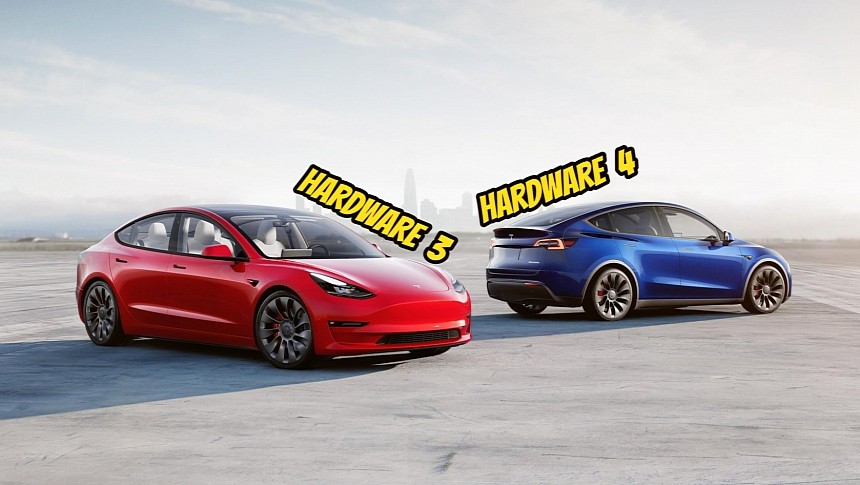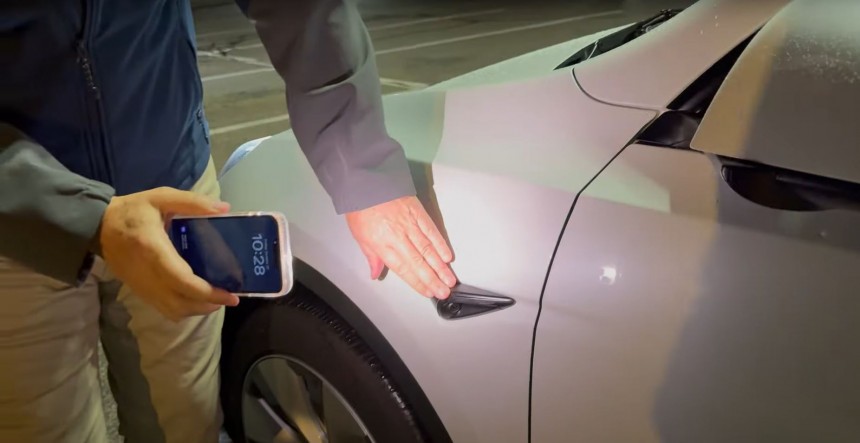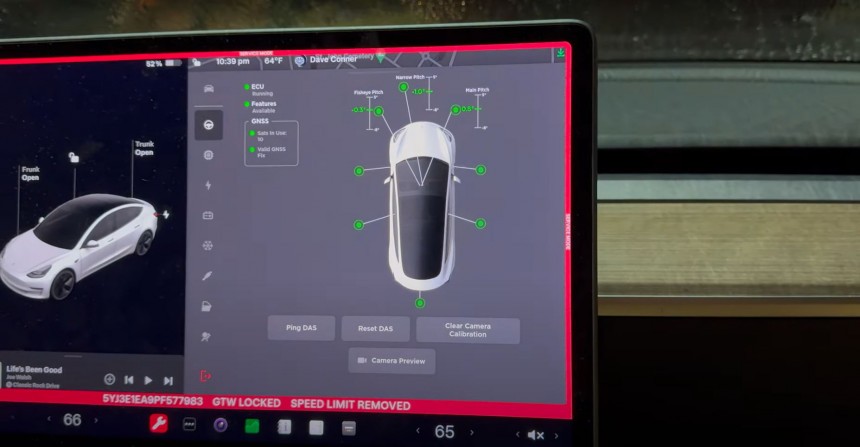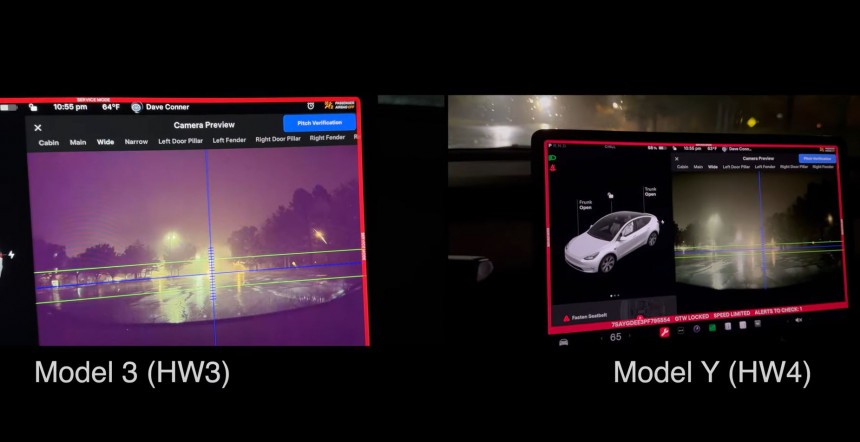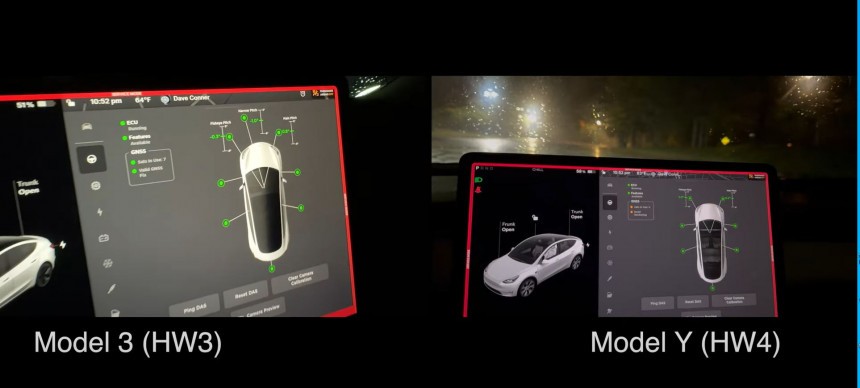Some say that Tesla EVs are iPads with wheels. That's a bit too harsh of a description. They certainly are zero-emission vehicles with a minimalist interior. But a Model X, for example, can't be reduced to just being a tablet with a car built around it. But should prospective customers make sure their EV boasts the latest internals? Here's a comparison that answers this question.
Earlier this year, Tesla started delivering cars equipped with the company's next-gen computer, dubbed as the Hardware 4. It included new cameras and more computing power.
All that sounds good, but there was one major problem – it couldn't run Full Self-Driving Beta (FSD Beta), and the brand didn't clearly disclose that. Most recently, however, that was fixed. Hardware 4-equipped EVs run the Level 2 driving assistance software.
It lags behind the Tesla EVs with Hardware 3, but that will happen until early 2024. Next year, Hardware 4 should become the main priority of Tesla's engineers as the out-of-beta neural nets-only FSD V12 is getting closer and closer to being ready for fleet-wide use.
When writing, most Tesla owners still can't comfortably use the complete $12,000 FSD Beta suite because the brand ditched radar and ultrasonic sensors in favor of cameras. Since Tesla refused to install a front bumper camera even on the refreshed Model 3, important measurements are still erroneously displayed when maneuvering in a tight parking lot.
On top of that, great functionalities like Smart Summon (the car can travel to you by using the app) still do not work accurately. For a while, they didn't work at all. So, Tesla is making some progress in this regard as it moved to streamline production and save money by eliminating ultrasonic sensors and radars.
However, it might not matter all that much when it comes to "computers on wheels."
A Tesla Model 3 RWD with Hardware 3 and a Tesla Model Y with Hardware 4 are put head to head in a comparison to determine if the newer cameras are much better than the old ones. Since the brand decided to rely only on these optical units, they are incredibly important. These cameras are paramount for emergency safety assistance systems!
It's also important to note that upgrading from Hardware 3 to Hardware 4 is impossible. The company's CEO confirmed it, and curious third parties said it was true.
A Tesla Model 3 RWD owner (who will soon upgrade to a Model X) explains that they noticed a major improvement in image quality when they drove a Model Y with Hardware 4. But that seems not to be the case any longer. The Hardware 3-equipped Tesla also benefitted from a software change that improved the image quality displayed on the center screen.
But that's not enough to conclude which is better. By placing the car in Service Mode, a father and son who run various social media accounts under the "Out of Spec" moniker can access all the hidden settings, including the camera previews.
They first notice that the newer Model Y does not have a narrow-pitch camera. However, things soon unravel, and the Hardware 4 suite comes on top. On a rainy night, the unprocessed footage looks much better on the crossover SUV than on the sedan.
Elon Musk recently demoed the FSD V12, and it tried to run a red light. The software is clearly not ready to operate like what Waymo and Cruise have on their hands - truly driverless cars.
Still, the move from Hardware 3 to Hardware 4 shows Tesla understood the need for better image quality and dealt with it. The problem is that other competitors do not dare to rely solely on cameras to turn their vehicles autonomous. They use ultrasonic sensors, radars, and some, like Polestar, will even offer customers the option to put a LiDAR on their cars.
The bottom line is - Tesla makes great commuting appliances. If you don't care about having your EV become a robotaxi, then you will be just fine with using Autopilot.
Thus, if you want a Tesla, buy one. You don't need to pay attention to what the CEO's doing or saying. You don't have to spend time talking to enthusiasts or dig around the infotainment system. You also don't have to deal with vehicles not built from the ground up to be great all-electric cars, which might also be more expensive than a Tesla.
Leasing a Model 3 nowadays could cost less than $400 per month. That looks like a bargain in today's car market and with these high interest rates. That's especially true when you consider that charging at home is cheaper than gas. The latter is expensive when writing and has a fluctuating price depending on what people in the Middle East decide to do. Electricity, not at all.
Just keep in mind that insurance might be pricey because Tesla EVs get totaled easily due to their complex build. It costs more to repair than replace, which is not a very environmentally friendly trait. But, then again, EVs aren't the best solution to tackle global warming, but are a good step in the right direction.
All that sounds good, but there was one major problem – it couldn't run Full Self-Driving Beta (FSD Beta), and the brand didn't clearly disclose that. Most recently, however, that was fixed. Hardware 4-equipped EVs run the Level 2 driving assistance software.
It lags behind the Tesla EVs with Hardware 3, but that will happen until early 2024. Next year, Hardware 4 should become the main priority of Tesla's engineers as the out-of-beta neural nets-only FSD V12 is getting closer and closer to being ready for fleet-wide use.
When writing, most Tesla owners still can't comfortably use the complete $12,000 FSD Beta suite because the brand ditched radar and ultrasonic sensors in favor of cameras. Since Tesla refused to install a front bumper camera even on the refreshed Model 3, important measurements are still erroneously displayed when maneuvering in a tight parking lot.
Zooming out
But should you care what type of internals your next Tesla will have? Normally, anyone would like to upgrade to the latest and greatest. That's why smartphone companies release a new flagship every year and still have great sales results despite incremental improvements.However, it might not matter all that much when it comes to "computers on wheels."
A Tesla Model 3 RWD with Hardware 3 and a Tesla Model Y with Hardware 4 are put head to head in a comparison to determine if the newer cameras are much better than the old ones. Since the brand decided to rely only on these optical units, they are incredibly important. These cameras are paramount for emergency safety assistance systems!
The same parts, but different components
Both cars have a suite of nine cameras: three on the windshield (placed in a heated housing), one repeater camera hidden into the fender indicator housings, one in each B pillar, one above the license plate, and another one monitoring the cabin.A Tesla Model 3 RWD owner (who will soon upgrade to a Model X) explains that they noticed a major improvement in image quality when they drove a Model Y with Hardware 4. But that seems not to be the case any longer. The Hardware 3-equipped Tesla also benefitted from a software change that improved the image quality displayed on the center screen.
But that's not enough to conclude which is better. By placing the car in Service Mode, a father and son who run various social media accounts under the "Out of Spec" moniker can access all the hidden settings, including the camera previews.
It's not looking good
But things go south quickly. They conclude that the autonomous driving promised by what FSD Beta should become after it's eventually polished (which should translate into turning Tesla EVs into robotaxis) might not be feasible in all weather conditions for quite some time. Thus, people could still end up paying $12,000 or $199 per month and remain testers of unfinished software for a long, long period.Elon Musk recently demoed the FSD V12, and it tried to run a red light. The software is clearly not ready to operate like what Waymo and Cruise have on their hands - truly driverless cars.
Still, the move from Hardware 3 to Hardware 4 shows Tesla understood the need for better image quality and dealt with it. The problem is that other competitors do not dare to rely solely on cameras to turn their vehicles autonomous. They use ultrasonic sensors, radars, and some, like Polestar, will even offer customers the option to put a LiDAR on their cars.
Keeping it simple is for the best
That's an adaptive cruise control system that helps you stay in your lane while on highways, keeps the distance from the vehicle in front of you, and can adjust the speed based on what the traffic signs say. It's all most car owners will ever need, considering that running FSD Beta on city streets can be an anxiety-inducing activity that keeps you focused on what the car is doing instead of paying full attention to traffic conditions.Thus, if you want a Tesla, buy one. You don't need to pay attention to what the CEO's doing or saying. You don't have to spend time talking to enthusiasts or dig around the infotainment system. You also don't have to deal with vehicles not built from the ground up to be great all-electric cars, which might also be more expensive than a Tesla.
Leasing a Model 3 nowadays could cost less than $400 per month. That looks like a bargain in today's car market and with these high interest rates. That's especially true when you consider that charging at home is cheaper than gas. The latter is expensive when writing and has a fluctuating price depending on what people in the Middle East decide to do. Electricity, not at all.
Just keep in mind that insurance might be pricey because Tesla EVs get totaled easily due to their complex build. It costs more to repair than replace, which is not a very environmentally friendly trait. But, then again, EVs aren't the best solution to tackle global warming, but are a good step in the right direction.
